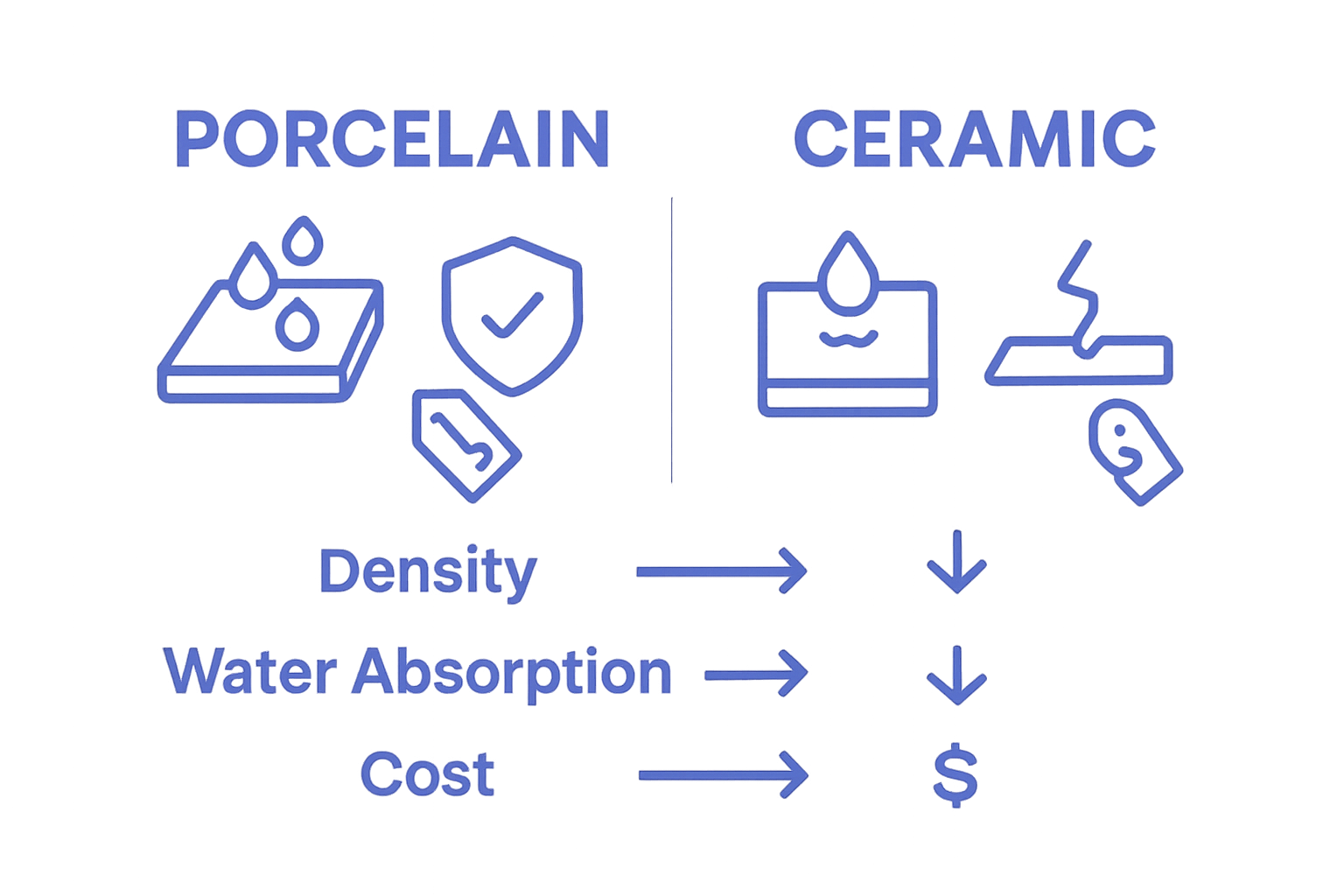Understanding the Difference Between Porcelain and Ceramic Tile
Posted by Mike Belk on Aug 25, 2025

Porcelain and ceramic tiles might seem nearly identical on the surface, used everywhere from cozy kitchens to chic hotel lobbies. Yet only one of them is fired at over 2,200 degrees Fahrenheit and absorbs less than 0.5 percent of its weight in water. Most people think the real difference is just in the price tag or pretty patterns. The real surprise is how these quiet details shape durability, beauty and performance in places you never even notice.
Table of Contents
- Defining Porcelain And Ceramic Tile: Materials And Composition
- Key Differences In Performance And Durability
- Aesthetic Appeal: Color, Texture, And Design Choices
- Cost Factors: Pricing And Value In Different Contexts
- Practical Applications: Where To Use Each Type Of Tile
Quick Summary
| Takeaway | Explanation |
|---|---|
| Porcelain tiles are denser and more durable. | Their higher density results in superior wear resistance and lower water absorption, making them ideal for high-traffic areas. |
| Ceramic tiles are more affordable but less durable. | While initial costs are lower, ceramic tiles may need more frequent replacement due to higher wear rates. |
| Porcelain tiles excel in outdoor and moist environments. | With lower water absorption, they are suitable for exterior applications and areas prone to moisture exposure. |
| Aesthetic versatility varies between tile types. | Porcelain tiles allow for intricate designs, while ceramic tiles offer vibrant colors, ideal for decorative uses. |
| Consider traffic intensity when choosing tiles. | Porcelain is recommended for high-traffic residential areas, while ceramic is better for low-traffic decorative surfaces. |
Defining Porcelain and Ceramic Tile: Materials and Composition
Porcelain and ceramic tiles are foundational materials in modern construction and design, often mistaken as identical despite their nuanced differences. While both originate from clay and undergo firing processes, their composition, manufacturing techniques, and performance characteristics vary significantly.
Clay Composition and Manufacturing Process
At their core, ceramic and porcelain tiles are clay-based products transformed through high-temperature kiln firing. According to research published in IOPscience, the primary distinction lies in their raw material selection and production methods. Ceramic tiles are typically crafted from red or white clay mixtures, fired at lower temperatures, resulting in a more porous material. Porcelain tiles, conversely, utilize refined porcelain clay with higher feldspar content, fired at substantially higher temperatures exceeding 2,200 degrees Fahrenheit.
Key characteristics of these tile types include:
- Ceramic Tiles: Lower density, more affordable, easier to cut
- Porcelain Tiles: Higher density, more durability, lower water absorption
Technical Properties and Performance
The manufacturing nuances directly influence tile performance. The National Kitchen & Bath Association highlights that porcelain tiles possess remarkable technical advantages. Their dense composition results in significantly lower water absorption rates, making them frost-resistant and suitable for both indoor and outdoor applications. Ceramic tiles, while versatile, typically demonstrate higher water absorption and are best suited for interior spaces with moderate foot traffic.
For homeowners considering tile selection, read more about tile performance characteristics, understanding these fundamental differences becomes crucial in making informed design and durability decisions.
To help clarify the specific characteristics that distinguish porcelain and ceramic tiles, the following comparison table breaks down their differences across several important categories.
| Feature/Characteristic | Porcelain Tile | Ceramic Tile |
|---|---|---|
| Density | High (very dense) | Medium (less dense) |
| Water Absorption | Less than 0.5% | Higher (typically more than 0.5%) |
| Firing Temperature | Over 2,200°F | Lower than porcelain |
| Durability | Superior wear and impact resistance | Less durable, more prone to wear |
| Frost Resistance | Yes | Typically no |
| Application Suitability | Indoor/outdoor, high-traffic, moist areas | Indoor, moderate or low-traffic areas |
| Installation Cost | Higher | Lower |
| Design Versatility | Intricate patterns, texture replication | Vibrant colors, decorative uses |
Key Differences in Performance and Durability
The performance and durability of porcelain and ceramic tiles represent critical factors in selecting the right flooring or surface material for specific environments. While both materials share foundational similarities, their distinct manufacturing processes yield significantly different performance characteristics.
Wear Resistance and Structural Integrity
Porcelain tiles demonstrate superior wear resistance due to their dense composition and manufacturing process. According to research from the National Park Service, porcelain’s refined clay composition and higher firing temperatures create a significantly harder, less porous material. This translates into enhanced durability across various applications.

Key performance differences include:
- Porcelain Tiles: Higher impact resistance, lower water absorption, suitable for high-traffic areas
- Ceramic Tiles: Lower impact resistance, higher water absorption, best for moderate traffic environments
Environmental and Application Suitability
The structural differences between porcelain and ceramic tiles dramatically influence their environmental adaptability. Porcelain tiles excel in challenging environments, offering frost resistance and superior moisture protection. Their low water absorption rate makes them ideal for outdoor spaces, commercial settings, and areas with extreme temperature fluctuations. Ceramic tiles, while versatile, are more limited in their application range.
Critical environmental performance factors include:
- Frost resistance levels
- Moisture absorption rates
- Temperature tolerance
- Potential for cracking or chipping
Explore detailed tile performance comparisons to understand which material best suits your specific project requirements and environmental conditions.
Aesthetic Appeal: Color, Texture, and Design Choices
Aesthetic versatility represents a critical consideration when selecting between porcelain and ceramic tiles, with each material offering unique design possibilities that cater to diverse architectural and interior design preferences. The visual and tactile characteristics of these tiles go far beyond mere surface decoration, reflecting sophisticated manufacturing technologies and artistic innovation.
Color Spectrum and Visual Complexity
According to research from the Whole Building Design Guide, both porcelain and ceramic tiles have dramatically expanded their design potential through advanced manufacturing techniques. Porcelain tiles excel in high-resolution pattern replication, offering remarkable depth and nuance in visual representation. Their dense composition allows for more intricate design mimicry, including near-perfect representations of natural stone, wood grain, and complex textural landscapes.
Design characteristics include:
- Enhanced color consistency
- Ability to replicate natural material textures
- Sophisticated digital printing techniques
- Wider range of visual interpretations
Texture and Surface Variation
The surface treatment of tiles significantly influences their aesthetic and functional appeal. Porcelain tiles offer superior texture diversity, enabling designers to create spaces with remarkable visual depth. Ceramic tiles, while more limited, provide vibrant color options and traditional glazing techniques. Digital printing technologies have revolutionized both tile types, allowing for unprecedented design flexibility.
Discover more about tile surface design nuances to understand how modern manufacturing techniques are transforming interior design possibilities. The interplay between material composition, manufacturing precision, and artistic vision continues to push the boundaries of tile aesthetics.
Cost Factors: Pricing and Value in Different Contexts
Understanding the financial implications of choosing between porcelain and ceramic tiles involves more than comparing initial purchase prices. The true value encompasses installation costs, long-term durability, maintenance expenses, and performance characteristics that influence overall investment potential.
Initial Purchase and Installation Costs
According to the National Kitchen & Bath Association, porcelain and ceramic tiles present significantly different cost structures. Porcelain tiles typically demand a higher upfront investment, reflecting their superior manufacturing process and enhanced durability. The price differential stems from more complex production requirements, including higher firing temperatures and refined clay compositions.
Key cost considerations include:
- Material cost per square foot
- Installation complexity
- Required specialized tools or expertise
- Potential additional substrate preparation
Long-Term Value and Maintenance Expenses
While ceramic tiles offer a more budget-friendly initial purchase price, porcelain tiles provide substantial long-term value through reduced maintenance and replacement costs. Porcelain’s dense composition translates into superior wear resistance, potentially extending the tile’s functional lifespan by several years compared to standard ceramic options.
Maintenance cost factors encompass:
- Frequency of repairs
- Replacement interval
- Cleaning and preservation expenses
- Potential value addition to property
Explore detailed tile cost analysis and value comparisons to make an informed decision that balances immediate affordability with sustained performance and aesthetic appeal.
Practical Applications: Where to Use Each Type of Tile
Selecting the appropriate tile type requires understanding the specific performance characteristics and environmental demands of different spaces. Porcelain and ceramic tiles each possess unique attributes that make them suitable for distinct applications, ranging from residential interiors to commercial environments.
Residential Space Considerations
In residential settings, the choice between porcelain and ceramic tiles depends on traffic intensity, moisture exposure, and aesthetic requirements. Porcelain tiles excel in high-traffic areas such as entryways, kitchens, and living spaces where durability is paramount. According to experimental research, porcelain’s superior mechanical properties make it ideal for spaces requiring robust performance.
Ideal residential applications include:
- Kitchen flooring with heavy foot traffic
- Bathroom walls and floors with moisture exposure
- Entryway and hallway surfaces
- Living room accent walls
Commercial and Specialized Environments
Ceramic tiles shine in areas prioritizing aesthetic versatility, such as decorative wall treatments, low-traffic commercial spaces, and design-focused environments. While less durable than porcelain, ceramic tiles offer remarkable design flexibility and cost-effectiveness. Their lighter composition makes them suitable for spaces with minimal structural stress.
Learn more about selecting the right tile for specific spaces, understanding that each environment demands a nuanced approach to material selection. The key is matching tile characteristics with functional requirements and design vision.
The following table summarizes the ideal use cases for porcelain and ceramic tiles in both residential and commercial settings based on the information discussed in the article.
| Location/Use | Recommended Tile Type | Reasoning/Benefits |
|---|---|---|
| High-traffic entryways | Porcelain | Superior durability and wear resistance |
| Bathroom floors and walls | Porcelain | Low water absorption, moisture resistance |
| Kitchen flooring | Porcelain | Withstands heavy use and spills |
| Living room accent walls | Ceramic | Aesthetic flexibility, lower traffic |
| Decorative wall treatments | Ceramic | Vibrant colors, suitable for low-impact areas |
| Outdoor applications | Porcelain | Frost and moisture resistant |
| Low-traffic commercial areas | Ceramic | Budget-friendly, design options |

Find the Right Tile Solution with Confidence at BELK Tile
Are you feeling overwhelmed by the subtle differences between porcelain and ceramic tiles? Whether you are worried about choosing materials with the right water absorption, wear resistance, or design flexibility, making the wrong choice can lead to costly mistakes. You deserve peace of mind in selecting tiles that stand up to your project’s requirements and reflect your personal style. Our comprehensive tile collection makes it easy to put all your new knowledge into action.
Explore product listings that highlight technical specs and real-life applications, just as discussed in the article. Experience effortless navigation and powerful filters that guide you to options tailored for every need, whether it is a high-traffic entry, a beautiful bathroom, or a stylish kitchen backsplash. Uncover the best blend of performance and style now at BELK Tile. Ready to make your tile selection stress-free? Start browsing or contact our experts at BELK Tile to transform your vision into reality.
Frequently Asked Questions
What is the main difference between porcelain and ceramic tiles?
Porcelain tiles are made from more refined clay and fired at higher temperatures, making them denser and less porous than ceramic tiles, which are generally made from red or white clay and fired at lower temperatures.
Are porcelain tiles more durable than ceramic tiles?
Yes, porcelain tiles are more durable due to their higher density and lower water absorption rates, making them better suited for high-traffic areas and environments with moisture exposure compared to ceramic tiles.
Can I use ceramic tiles in outdoor applications?
Ceramic tiles are typically not recommended for outdoor use because of their higher water absorption rates and lower frost resistance, making porcelain tiles a better choice for outdoor applications.
How do I choose between porcelain and ceramic tiles for my home?
Consider the tile’s intended use: for high-traffic or moisture-prone areas, porcelain tiles are ideal due to their durability. Ceramics offer more design flexibility and are suitable for lower-traffic areas. Assess both aesthetic needs and functional performance before making your choice.



